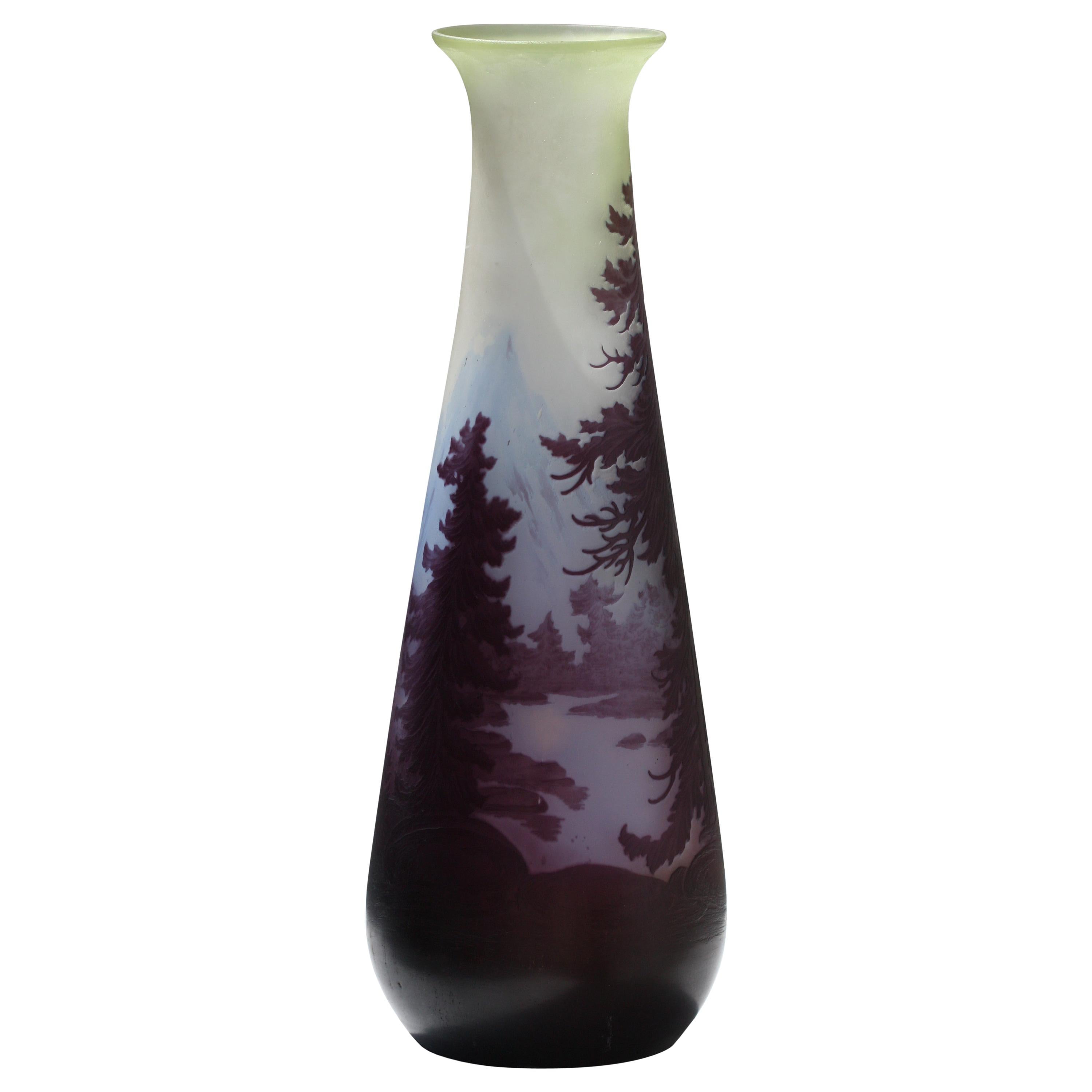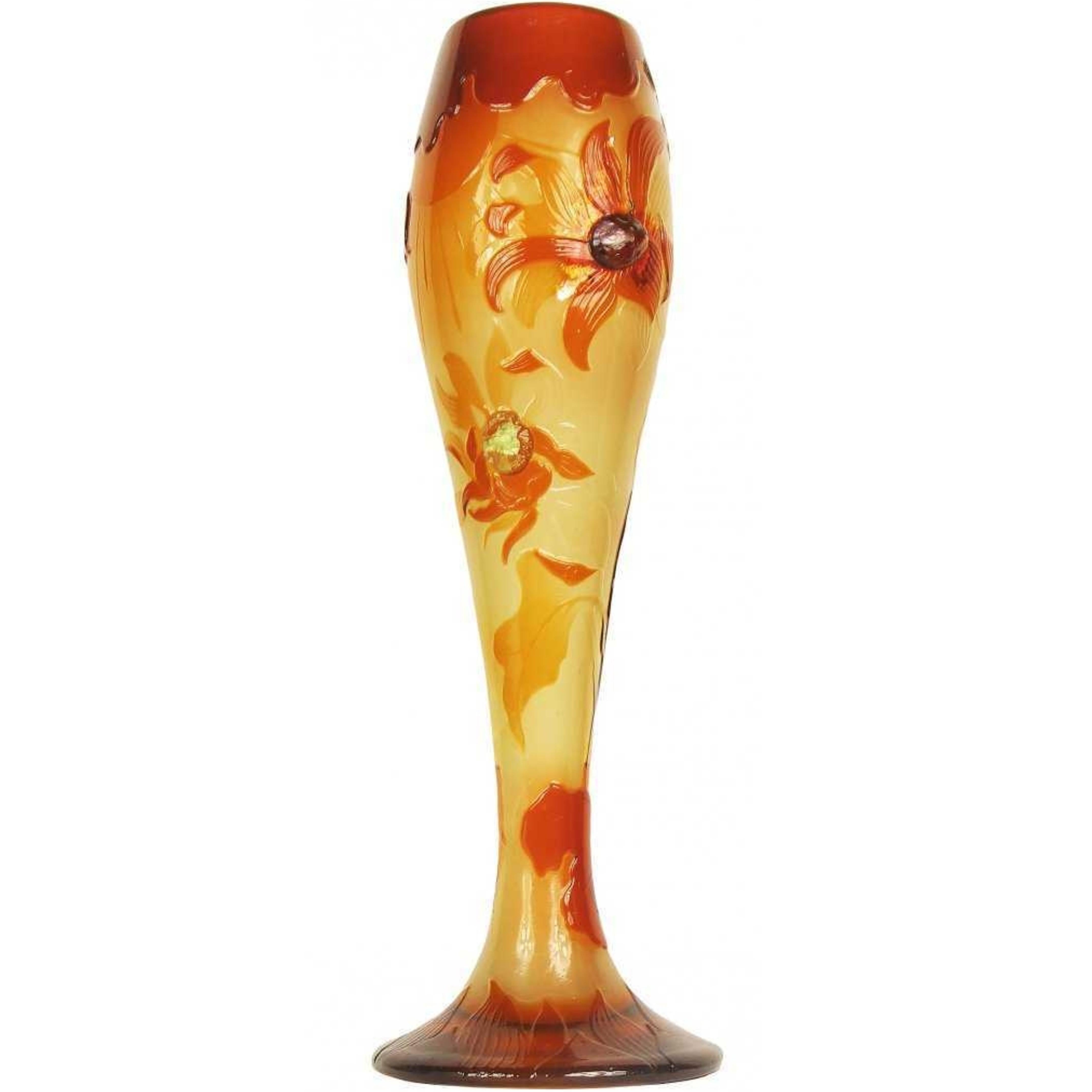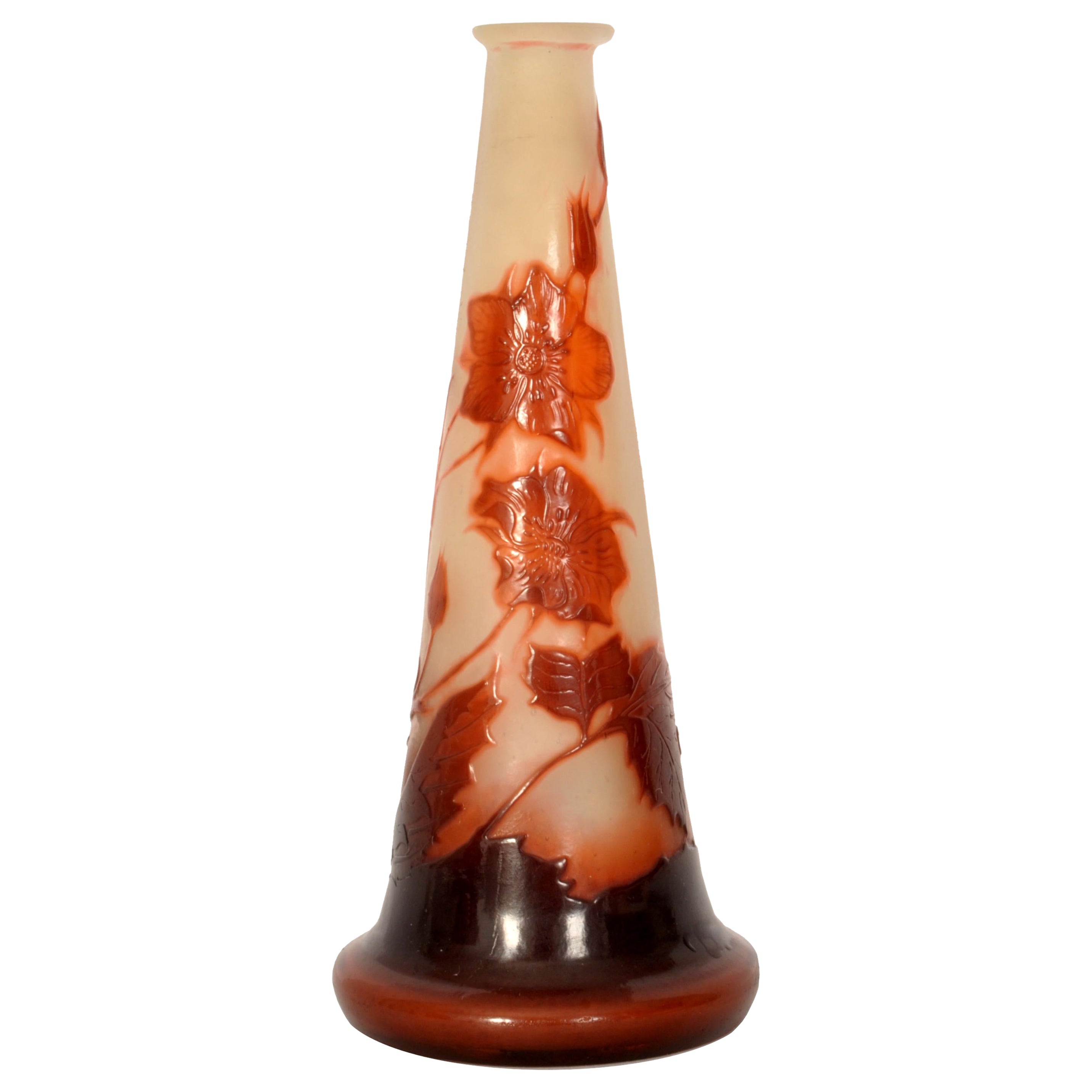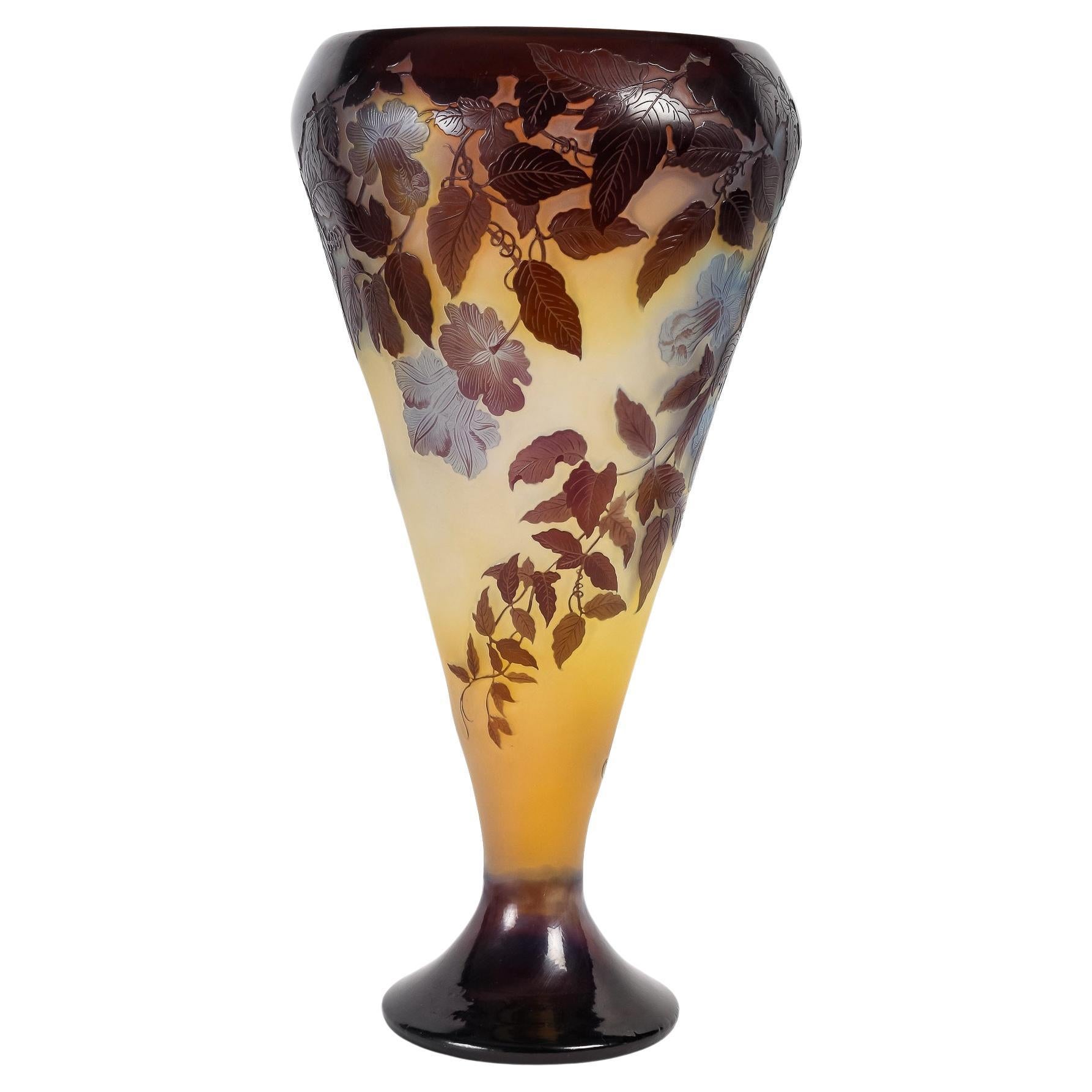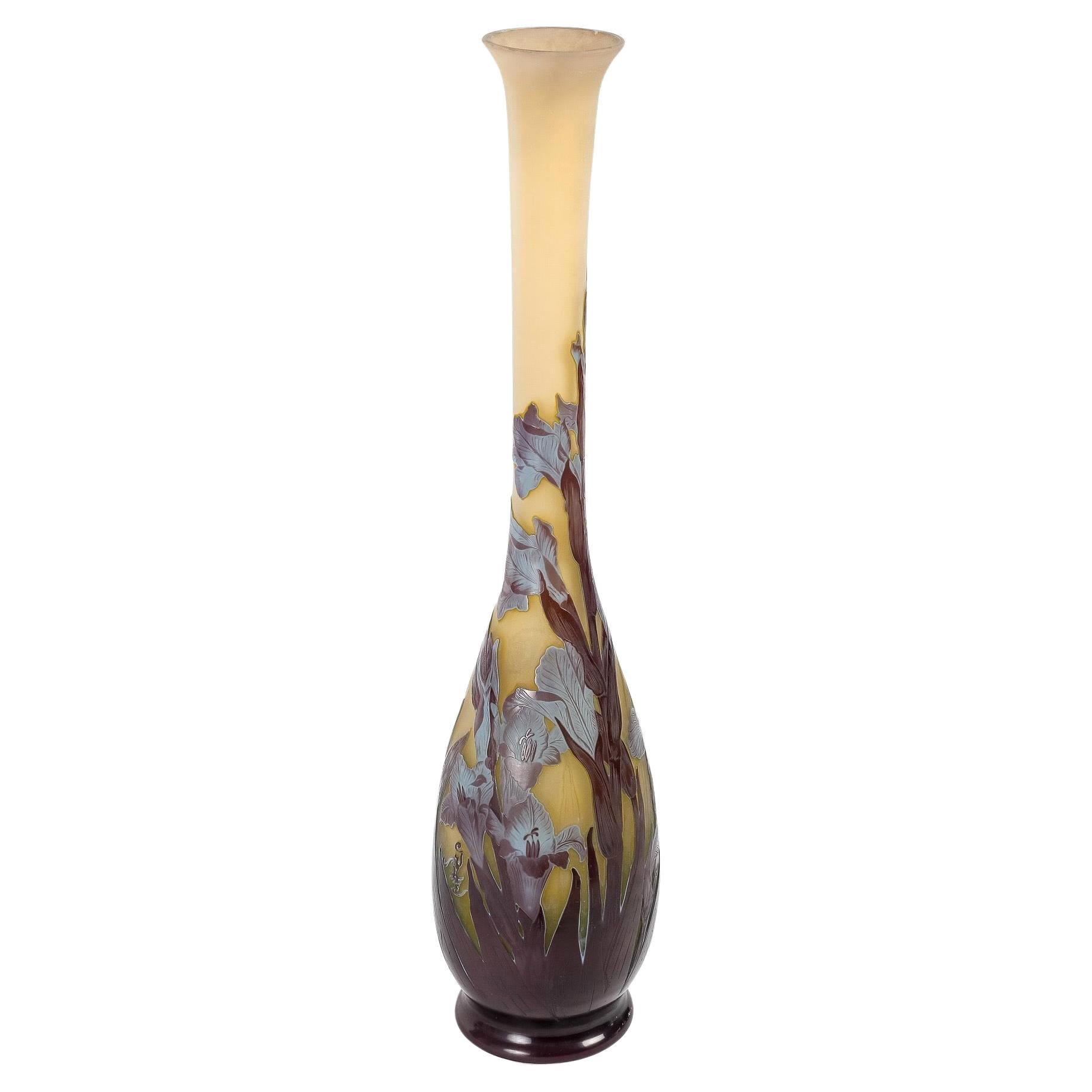Items Similar to ÉMILE GALLÉ 'Iris' Vase, circa 1900 overlaid cameo and fire polished glass
Want more images or videos?
Request additional images or videos from the seller
1 of 7
ÉMILE GALLÉ 'Iris' Vase, circa 1900 overlaid cameo and fire polished glass
About the Item
ÉMILE GALLÉ (1846-1904)
Rare and important 'Iris' Vase, circa 1900
Overlaid cameo and fire polished glass, well documented in books and exhibitions
Signed in cameo Gallé.
Measurements :
Height : 9 in. (22.9 cm)
Diameter : 5 in. (12.7 cm)
Condition
Perfect condition for its age, no brakes, no restorations.
Émile Gallé (8 May 1846 in Nancy – 23 September 1904 in Nancy) was a French artist and Designer who worked in glass, and is considered to be one of the major innovators in the French Art Nouveau movement. He was noted for his designs of Art Nouveau glass art And Art Nouveau furniture, and was a founder of the École de Nancy or Nancy School, a Movement of design in the city of Nancy, France.
This vase in the literature:
G. de Bartha and A. Duncan, Glass by Gallé, London, 1984, p. 93 (for a related example).
Émile Gallé et le verre la collection du Musée de l’École de Nancy, exh. cat., 2004, Paris, p. 136, no. 217 (for a related example).
B. Hakenjos, Émile Gallé: Keramik, Glas und Möbel des Art Nouveau, Volume 1, Munich, 2012, p. 139 (for a related example).
B. Hakenjos, Émile Gallé: Keramik, Glas und Möbel des Art Nouveau, Volume 2, Munich, 2012, p. 141 (for a related example).
Two major glass style made by Galle:
Cased glass, cameo glass and enamel glass:
Cased glass and cameo glass were two techniques often used by Gallé. Cased glass was Made of two different layers of glass of different colors, fused together by heat. The first Case of layer is made in a cold. When it is finished and cooled, a second layer is blown Inside the first Then the piece is placed into the furnace, so the two layers fuse together. This could be repeated for multiple layers of glass. Cameo glass was a means of Decorating cased glass. The cased glass of two or more colors was carved with a Diamond saw or etched with acid, so that the colors of the layer underneath were visible And created a design. Enamel glass was decorated on the outside by a brush of enamels Colored by metallic oxides.
Glass marquetry and patinated glass:
Gallé continually experimented with new techniques of glass art. One of his major Innovations was glass marquetry, or applying layers of glass on an object. He attached Then sheets of colored glass onto a hot glass object He could join the laminations or Overlay them, adding an infinite number of layers and colors. This technique had been Practiced by the Venetians during the Renaissance, but Gallé pushed it much further. While it allowed him almost limitless variations, it also presented great difficulties, since The glass had to be reheated for each new layer, and could easily crack.
Another difficulty was the appearance of defects and imperfections caused by Contamination of the glass paste by dust or ashes or other materials, which caused what Glassmakers called "bubbles", "grease" or stitches" inside the glass. Galleé decided to Take advantage of the defects. He wrote in his patent application, "Concerned about Such defects, I had the idea of using them as a decorative means, which permitted me, By inducing the effect in various ways, to obtain an entirely new type of decoration, called Patina." Gallé proposed dusting the surface of the hot glass, which would give the Appearance of fabric, or thick cobweb, or other textures. He proposed to make further Decoration the surface with engraving, sand blasting, and wheel carving, and to embed Fragments of hot glass into this patina or outer layer. The final result would then be Covered with a thin layer of clear crystal, which could be left plain or also patinated.[10]
- Creator:Emile Gallé (Artist)
- Dimensions:Height: 9 in (22.86 cm)Diameter: 5 in (12.7 cm)
- Style:Art Nouveau (Of the Period)
- Materials and Techniques:
- Place of Origin:
- Period:
- Date of Manufacture:1900
- Condition:Wear consistent with age and use. Perfect condition for its age, no brakes, no restorations.
- Seller Location:Tel Aviv - Jaffa, IL
- Reference Number:1stDibs: LU8130235520322
About the Seller
No Reviews Yet
Vetted Seller
These experienced sellers undergo a comprehensive evaluation by our team of in-house experts.
1stDibs seller since 2023
- ShippingRetrieving quote...Ships From: Tel Aviv - Jaffa, Israel
- Return PolicyThis item cannot be returned.
More From This SellerView All
- ÉMILE GALLÉ Vase, circa 1900 overlaid cameo glass red flowers, square shapeLocated in Tel Aviv - Jaffa, ILAn attractive late 19th Century cameo glass vase of elongated square form cut with decorative burgundy and red flowers against a warm yellow background with excellent hand finished d...Category
Antique 1890s Vases
MaterialsCut Glass, Blown Glass, Art Glass
- Rare Daum Nancy Wheel-Carved Rose 'La France' double overlay Cameo Glass VaseBy DaumLocated in Tel Aviv - Jaffa, ILThis wonderful, elegantly shaped with a flared rim vase , by Daum Nancy, features wheel-carved cameo glass of the highest quality detailing an amazing pink roses, or rose of France ...Category
Vintage 1910s French Art Nouveau Vases
MaterialsArt Glass, Blown Glass, Cut Glass, Opaline Glass
- Large Austrian Silver “Peacock” Hanukkah Lamp, Josef Kohn, Vienna, 1872-1900s'Located in Tel Aviv - Jaffa, ILVery rare and important Austrian silver, from its golden age of the late 19th century to the early 20th century, this Hanukah lamp is hand with chased dra...Category
Antique 1890s Art Nouveau Sterling Silver
MaterialsSilver
- Rare Antique Novelty German silver antler and silver cigar cutter, 1890-1900Located in Tel Aviv - Jaffa, ILVery attractive German silver mounted on an antler, cigar cutter This cigar cutter is designed as oak leaves falling on the antler and in the middle There is a game bird of some kind hung from it, very realistic and well made. This kind of objects were made in Germany and Austria so they can be given as High end gifts, used as a display piece with function in men clubs...Category
Antique 1890s Sterling Silver
MaterialsSilver, Steel
- Satsuma earthenware vase by kinkozan, Meiji periodBy KinkozanLocated in Tel Aviv - Jaffa, ILthe body of this small marvelous vase is painted with a scene of a puppet show vendor with his wood backpack, on top of the backpack there are toys and dolls, he is surrounded with a group of 6 children, and on the background you can see a village. on the other side of the vase there is an amazing painting of flowers and on the sides there are two amazing strong pine trees, the amorphous background is decorated in a "Tortoiseshell" color and design that gives it a real character and which is quite rare to see on satsuma pottery. all the vase is over richly overpainted over the glaze with gold, which gives it its depth and realism. signed Kyoto Kinkozan zo, and sealed Kinkozan zo Kyoto’s Satsuma: The painting technique used in Kyoto’s Satsuma-style ware is said to be the invention of the sixth generation Kinkōzan Sōbei (1824–1884). The Kinkōzan were a famous family of Kyoto Awataguchi potters who made ceramics that were used at Shōren'in, a temple closely tied to the imperial family, and by the shoguns of the Edo government. In fact the shogun is said to have granted them the name Kinkōzan. With the upheavals at the end of the Edo period, however, and the reforms of the subsequent Meiji government, the potters lost their traditional patrons and had to develop new markets. Just at that time, the visit of a certain Westerner is said to have decided them to embark on overseas trade. By 1870, they had perfected Kyō Satsuma...Category
Antique 1890s Japanese Meiji Ceramics
MaterialsGold
- Antique Russian Silver Enamel chest shaped box, by Maria Semenova, Moscow ca1900By Maria SemenovaLocated in Tel Aviv - Jaffa, ILThis treasure chest shaped box is luxuriously decorated and dates from the final decades Of the Imperial period. The box was produced by the workshop of Maria Semonova and Is formed of 875 grade silver with silver-gilt utilised throughout. the box is of traditional Shape, having two hinged handles and a clasp, boxes like this were used in treasurys Around the globe in the early days to keep valuables inside, this small box can be used To hold tobacco or just sit on your table as a statement piece, a great addition to any Silver and especially Russian silver collection. The exterior surface of the box is profusely decorated with polychrome cloisonné Enamel, the cloisons set into a variety of shapes, such as scrolling arabesques, and Infilled with shaded enamel in tones of red, blue, and Semenova’s idiosyncratic violet. The cloisons are bounded by silver-gilt rope twist cloison wire. The underside of the box Is marked with ‘MC’ for Semonova’s workshop, ‘84’ for 87.5% silver with a Kokoshnik mark (Kokoshnik is a traditional Russian head...Category
Early 20th Century Russian Neoclassical Decorative Boxes
MaterialsSilver, Enamel
You May Also Like
- Emile Galle Overlaid and Etched Glass Vase, circa 1900By Emile GalléLocated in West Palm Beach, FLAn Emile Galle overlaid and etched glass vase, circa 1900. The frosted white, yellow and blue ground overlaid and etched to depict a tree lined mountainous lake scene. Measures: 11 ...Category
Antique Early 1900s Vases
MaterialsArt Glass
- 'Dahlia' Fire-Polished Cameo Glass Vase, Signed by Emile Gallé, circa 1900By Emile GalléLocated in West Palm Beach, FLEmile Gallé, French (1846-1904) A very fine internally decorated fire-polished cameo glass vase with applied decoration, 'Dahlia', circa 1900 13.25 in. (33.6 cm.) high signed Gall...Category
Antique Early 1900s Vases
- Antique French Art Nouveau Fire Polished Cameo Glass Emile Gallé Stem Vase, 1900By Emile GalléLocated in Portland, ORA fine antique French Art Nouveau Emille Galle cameo glass vase, circa 1900. The stem vase of a tapering conical form and finely wheel carved and acid etc...Category
Antique Early 1900s French Art Nouveau Vases
MaterialsGlass
- Emile Galle Cameo Glass Vase 1900By Emile GalléLocated in Autonomous City Buenos Aires, CABAoverlaid and acid-etched with pendant flowers and leaves signed in cameo Gallé This beautiful glass vase is an authentic vase due to the petal-shaped mouth opening. very attractive...Category
Antique Early 1900s French Art Deco Vases
MaterialsGlass, Blown Glass, Art Glass
- Émile Gallé (1846-1904), Impressive Cameo Glass Vase "Bignones" circa 1900By Emile GalléLocated in Saint-Ouen, FRÉmile Gallé (1846-1904) Impressive Gallé French Cameo Glass Vase Large vase cone shape on pedestal Cased glass, opalescent, colorless, yellow and blue, acid-etched design with "Big...Category
Vintage 1910s French Art Nouveau Glass
MaterialsArt Glass
- Émile Gallé (1846-1904), Large Cameo Glass Vase "Gladioli" circa 1900By Emile GalléLocated in Saint-Ouen, FRÉmile Gallé (1846-1904), Art Nouveau Cameo Glass Vase « Gladioli Flowers » Large piriform vase on heel with long collar in dark blue and blue multi-layered glass Cased glass, opales...Category
Antique Early 1900s French Art Nouveau Glass
MaterialsArt Glass
Recently Viewed
View AllMore Ways To Browse
Nouveau Iris
Jasperware Green Vase
Vintage Southwestern Pottery
Handpainted Scroll
Paolo Venini Murrine
Selection Norm
Wooden Maple Leaf
Alexandrite Glass Vase
Vintage Rosenthal Paper Bag Vase
Daum Limited Edition Vase
Rosenthal Netter Numbered
Thomas Ivory Vases
Lalique Snail
Tessuti Battuti
Daum Iris Vase
Herend Large Vase
Societa Ceramica Richard
French Art Pottery Fish Pitcher
